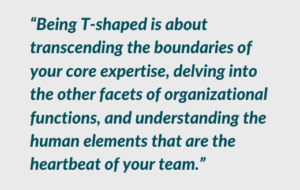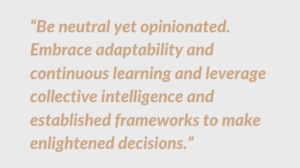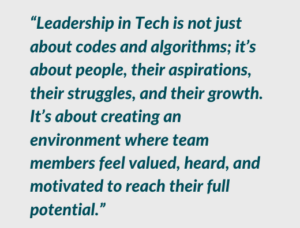7 Lessons for Managers in Engineering
By Bastian Buch
 Today I want to share some foundational leadership lessons I would tell my younger self about in retrospect. Over the last 16 years, I have worked in different roles in technology, starting with Regis24, a pioneering B2B (kind of) SaaS company specializing in refining customer master data for banks, insurances, and the like. Here, I introduced Agile and XP methodologies like TDD, Scrum, CI/CD, cross-functional teams, tech debt management, and QA Engineering (with tools such as Sonar). Since then, I’ve been an Engineering Manager and Head of Technology at Scout24, and an Engineering Director at renowned companies like travel tech unicorn Omio, food and grocery delivery giant DeliveryHero, and Europe’s fashion ecommerce champion, Zalando.
Today I want to share some foundational leadership lessons I would tell my younger self about in retrospect. Over the last 16 years, I have worked in different roles in technology, starting with Regis24, a pioneering B2B (kind of) SaaS company specializing in refining customer master data for banks, insurances, and the like. Here, I introduced Agile and XP methodologies like TDD, Scrum, CI/CD, cross-functional teams, tech debt management, and QA Engineering (with tools such as Sonar). Since then, I’ve been an Engineering Manager and Head of Technology at Scout24, and an Engineering Director at renowned companies like travel tech unicorn Omio, food and grocery delivery giant DeliveryHero, and Europe’s fashion ecommerce champion, Zalando.
As of August 2023 I’m an Executive Tech and Product Advisor at Philipps & Byrne, leading a team of consultants and aiding investors, founders, CTOs, and CPOs in sculpting their organizations and envisioning the future world. In tandem with this, I head a non-profit organization, The Mentoring Club, a global platform for mentoring and career growth, boasting nearly 10,000 members and 40,000 monthly users. It’s a remarkable community of mentors generously donating their time for mentees.
After these enriching years in leadership, here are my nuggets of wisdom that I deem universal. Whether you’re an aspiring engineering manager, a seasoned middle manager, or the technical co-founder of a startup, these insights will resonate with you.
Let’s start.
#1 Being T-Shaped Is Not Just an Abstract Concept
Lesson number one: Being T-shaped is not just an abstract concept. You’ve likely stumbled upon the term ‘T-shaped’ — it implies possessing deep expertise in one area, complemented by broad knowledge across multiple domains. Let’s dissect what it genuinely entails for an engineering leader.

Firstly, it’s important to remember that you’re not orchestrating a symphony of robots. You’re heading a diverse team of individuals, each with a unique mix of experiences, goals, and values, operating within an intricate ecosystem of teams and functions. Understanding the dynamics of motivation, learning, communities, and the interplay between processes and people is key to successful leadership.
My first management role was marked by a project steeped in Human Resources (Thanks to my remarkable manager and mentor back then). It was a venture into uncharted territories, implementing a comprehensive performance management system, introducing salary bands, promotions, and performance measures, and understanding employee engagement. This was such a key experience for me, understanding that becoming a manager and leader is so much more about people and organizations than it is about technology.
Since then I have followed that same principle: underscoring the importance of a multifaceted knowledge base — from the nuances of Product and Marketing to the intricacies of Finance and Business Development. It’s this diverse knowledge spectrum that elevates a leader from good to exceptional. And, acquiring such broad knowledge, experience, and most importantly your own opinions and standpoints is not merely a ‘nice-to-have’ — it’s indispensable.
Reflecting on the invaluable advice from my manager and mentor at Regis24 during those formative years, he emphasized, “Read extensively and incessantly, encompassing a myriad of topics.” This advice resonated profoundly and since then reading is one of my major sources of learning and inspiration! Being T-shaped is about transcending the boundaries of your core expertise, delving into the other facets of organizational functions, and understanding the human elements that are the heartbeat of your team.
#2 The Danger of Attachment to Tools and Approaches
Let’s look into lesson number two: In technology, it’s a common pitfall to develop a strong attachment to specific tools, methodologies, or even programming languages. We’ve all experienced it — you’ve dedicated years to mastering Java, and then, out of the blue, you step into a new organization, and it’s all about the Microsoft stack. It feels like a curveball, doesn’t it?
 But here’s a reality check — this scenario reveals more about you than about the new team. Whether it’s Java, TypeScript, .NET, or any other tech stack, at its core, it’s just code. Each has its strengths, and their efficacy is contingent on a plethora of factors. Maintaining objectivity is crucial. This principle holds true across the board — whether it’s programming languages, the right tool, thought framework, leadership style, or methodologies like OKRs or any other organizational tool. What was a perfect fit in your previous role might not align with the ethos of your new organization. Perhaps, the CEO has an aversion to OKRs.
But here’s a reality check — this scenario reveals more about you than about the new team. Whether it’s Java, TypeScript, .NET, or any other tech stack, at its core, it’s just code. Each has its strengths, and their efficacy is contingent on a plethora of factors. Maintaining objectivity is crucial. This principle holds true across the board — whether it’s programming languages, the right tool, thought framework, leadership style, or methodologies like OKRs or any other organizational tool. What was a perfect fit in your previous role might not align with the ethos of your new organization. Perhaps, the CEO has an aversion to OKRs.
Does it render them ineffective? Absolutely not. So, what’s the optimal approach? Be neutral yet opinionated. Embrace adaptability and continuous learning and leverage collective intelligence and established frameworks to make enlightened decisions. And, most importantly, as a leader never shy away from charting a new course. Transcend the confines of your comfort zone, try shedding preconceived notions, and foster a culture of flexibility and innovation. Remember, the beauty of technology lies in its diversity and constant evolution.
#3 Everything Changes, Yet Everything Stays the Same
The next one sounds a bit paradoxical.
Let me illustrate with a story. In the yesteryears, our battles were against the compatibility issues between Internet Explorer 5 and Netscape. Fast forward to the present, and the battleground has shifted — it’s Desktop vs. Mobile Web or Android vs. iOS. 
Consider the evolution from monolithic architectures to microservices. Once, our focus was ensuring applications could scale vertically on single servers. Today, the narrative is about horizontal scaling across expansive cloud infrastructures.
Reflect on the metamorphosis of user experience. We’ve transitioned from the rudimentary simplicity of initial web pages to today’s interactive, dynamic interfaces. Different eras, analogous challenges.
The essence of this lesson? It’s about discerning the patterns in problem-solving. It’s about realizing that while the technological landscape undergoes relentless transformations, the foundational principles often endure.
As an engineer and leader, you need to develop your skills on two levels: Learning to handle new tools, applying new technologies, using new coding languages, etc. This is important, but what is even more essential is to master the universal skills of problem-solving, critical thinking, and creativity. Identify those analogies, assimilate them into your long-term muscle memory, and you’ll find yourself navigating new terrains with remarkable agility and adaptability.
#4 This Is a People Business
Lesson number four is a reality check, an important one. Here’s the unvarnished truth: From the vantage point of an investor or a CEO, the contentment of your team might be just a ‘nice-to-have’, a side effect, but not a tangible result. Quoting Andy Grove (former CEO at Intel), “You are responsible for the output and outcome of your team and the teams you influence.”
 However, here lies the paradox. Every creation, every innovation, is the brainchild of people — individuals who are intelligent, dynamic, and diverse. The elements of engagement, motivation, and mutual trust are the bedrock of successful projects, with great results.
However, here lies the paradox. Every creation, every innovation, is the brainchild of people — individuals who are intelligent, dynamic, and diverse. The elements of engagement, motivation, and mutual trust are the bedrock of successful projects, with great results.
Consider it akin to making soup. Water might not be the most flavorful component, but it is indispensable. So, what are the key questions you should never stop asking? Are your team members enveloped in a sense of value and appreciation? Is there a foundation of trust amongst colleagues? Is there a harmonious alignment between individual aspirations and the overarching goals of the company and your organization? Can they envisage their growth intertwined with the company’s vision? Keep asking these questions. They might not be the direct yardstick of your success, but their impact is undeniable. Before concluding this lesson, there’s a fundamental aspect I want to emphasize. In leadership, particularly in the tech domain, harboring a genuine affection for people is non-negotiable.
Yes, affection! Leadership in Tech is not just about codes and algorithms; it’s about people, their aspirations, their struggles, and their growth. It’s about creating an environment where team members feel valued, heard, and motivated to reach their full potential. It’s about intertwining the logical with the emotional, and the analytical with the empathetic, to build a leadership style that is profoundly human. In a lot of cases, this is not something to put on a board or executive management slide, so you need to do it for yourself, for your team, in silence and with an attitude of will and passion.
#5 Your Imposter Demon is Your Best Friend
Lesson number five might seem a bit unorthodox, but most of you will know what I am talking about. Welcome your constant companion in leadership: Your Imposter Demon. Yes, you read that right. Imposter Syndrome isn’t your foe; it’s a companion to embrace and learn from.
It’s perfectly acceptable to seek assistance. Keep probing, keep questioning, and remember, you’re not alone in this journey of uncertainties and self-doubt. My strategy? I maintain a database of concepts and terminologies that I encounter in meetings or stumble upon in articles, ones that are unfamiliar terrains to me. Every day, I allocate time to unravel to learn what they are about. The list seems endless, but the insights acquired are indispensable, particularly when you’re navigating the waters of leadership, new jobs, new technologies, and new industries.
For instance, when I transitioned to a new role a few years back, overnight, I found myself heading an organization that was responsible for heavy data streaming systems using technologies, many of which I heard about but never really worked with. That was painful, yet it helped me ask the right questions and work closely with Senior Engineers and Architects to understand the overall structure of our systems.
So, when your Imposter Demon knocks on your door next time, don’t turn it away. Engage in a dance with it. It’s through this intricate dance that you metamorphose, evolving into the leader you envision to be. Dancing with the Imposter Demon is not about conquering self-doubt but about leveraging it as a catalyst for growth and learning. It’s about acknowledging your limitations and transforming them into stepping stones for acquiring new knowledge and skills.
#6 It’s (Almost) Never About the Tech, It’s Always About the Product
In the initial phases of my journey, I remember fervent discussions within my teams about the supremacy of one technology over another, Linux vs. Microsoft vs. Apple, Java vs. PHP, etc. And indeed, it’s a crucial discourse within the team, but it is of almost no value, when it happens in a vacuum as an isolated conversation.
 Why? Because you’re not merely selecting technology; you’re devising solutions for user or business predicaments. Surprisingly, and perhaps counterintuitively, the ‘best’ tech isn’t always the most sophisticated or avant-garde. It might be more rudimentary, or it could involve acquiring an existing solution and layering it with customizations.
Why? Because you’re not merely selecting technology; you’re devising solutions for user or business predicaments. Surprisingly, and perhaps counterintuitively, the ‘best’ tech isn’t always the most sophisticated or avant-garde. It might be more rudimentary, or it could involve acquiring an existing solution and layering it with customizations.
The essence here is to deeply understand the product and the business landscape. Pose questions like: What’s the user base? How frequent is the utilization? What are the repercussions if it malfunctions? Is there a scope for exploration and innovation? Should it be open-source or proprietary? These questions change our traditional engineering domain; they intertwine with business and product considerations, and your technological choices should be in harmony with them!
So, the next time the allure of technology tempts you to focus exclusively on it, bear in mind, it’s not the destination but a conduit to crafting a phenomenal product. In the end, technology is just a tool to create products that solve real-world problems and add value to the users.
#7 Be aware of the Spotlight Effect
In the seventh and final lesson, I am going to explore a concept that is pivotal yet frequently neglected: the ‘Spotlight Effect.’ This is the psychological phenomenon where we believe we are constantly under scrutiny, that every eye is tuned to our successes or our stumbles.
Guess what! Most people don’t care: the majority of people are too immersed in their own worlds, their own challenges, and their own journeys to be incessantly observing yours. Feel like the world is conspiring against you? Chances are, it’s not a vendetta. It’s just the nature of our fast-paced world where your accomplishments might not always receive the spotlight you feel they deserve.
The journey of honing your skills, of acknowledging your own progress — these are fundamentally for your own fulfillment and growth. Your authentic self is revealed not in the spotlight, but in the quiet moments when no one is observing. Understanding the ‘Spotlight Effect’ is incredibly freeing. Realizing that you are not the center of everyone’s universe allows you to focus on what truly matters — your development, your team, and your shared goals.
